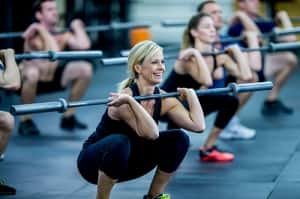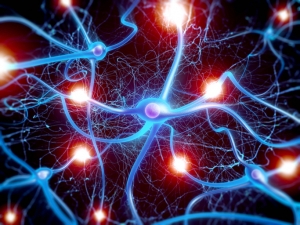Exercise Increases Neurons in the Brain

Julia Basso – PhD
Adult neurogenesis (i.e., the birth of new neurons in the adult brain) is a big thing in neuroscience. For a long time, neuroscientists thought that new neurons emerged only during stages of early development. In the 1960s, the discovery that new neurons continue to be born in the adult brain was met with much skepticism (Altman, 1962). We now know, however, that even the aging brain has the capacity to develop and grow new neurons.
These new neurons are important as they help our brains to learn and remember new information about our surrounding environment.
Luckily for us, one of the most tried and true ways to get new neurons growing in the brain is to exercise.
Related Article: Fitness Helps Brain Function As We Age
Neurogenesis
Neurogenesis is difficult, if not impossible, to measure in the human brain – so, the majority of studies examining neurogenesis have been conducted in rodents. That is, you get a rat to run on a wheel for an extended period of time, and new neurons are born in a brain region known as the hippocampus (Van Praag et al., 1999 a, b). The hippocampus is located in the center of the brain and is involved in a variety of processes including long-term memory, mood regulation, and our ability to navigate our environment.
What we see in humans is that exercise increases the size (Erickson et al., 2011) as well as the amount of blood that flows to the hippocampus (Pereira et al., 2007). These findings have been taken as “correlates of exercise-induced neurogenesis” in the human brain.
For several years,
we have known that continuous, aerobic exercise produces increases in hippocampal neurogenesis. As little as 3 days of free access to a running wheel causes an increase in the production of new neurons (Kronenberg et al., 2006). Of course, when given the opportunity to exercise, even for the first 3 days, rodents will get on that wheel and not stop running until it is taken away. Generally, with humans, you see a bit of a different story during the first 3 days of a new gym membership.
High-intensity aerobic exercise has lately received much attention as a more efficient way to reap the rewards of your workout routine. Indeed, studies have shown that short, but intense interval workouts can be just as beneficial in terms of cardiometabolic health as long, moderately-paced exercise regimens (Gillen et al., 2016). Because of these findings, neuroscientists are interested in whether or not these compressed workouts are just as beneficial as longer, endurance workouts for the brain.
Related Article: Brain Growth with Exercise
Recently,
a group of scientists at a university in Finland asked the question of whether high-intensity aerobic exercise was just as effective as continuous, aerobic exercise in causing adult hippocampal neurogenesis (Nokia et al., 2016). For 7 weeks, rats were given the opportunity to engage in continuous, aerobic exercise or high-intensity interval training (HIIT). The aerobic exercise group was simply given free access to a running wheel 7 days a week, whereas the HIIT group exercised 3 times per week. Each HIIT workout, conducted on a treadmill at 10% incline, consisted of a 5 minute warmup, followed by 3 minutes or running at 85-90% of maximal speed and then 2 minutes running at 50% of maximal speed. This protocol was conducted 3 additional times for a total HIIT workout of 20 minutes.
Additionally, the scientists were interested if changes in fitness level (VO2 max) corresponded to the changes in neurogenesis. Therefore, they conducted these exercise protocols in two populations: one group of rats who were bred to show large changes in fitness level with exercise (called high-response trainers), and one group of rats who were bred to show minimal changes in fitness level with exercise (called low-response trainers). Indeed, despite our best efforts to exercise, some human individuals do not show improvements in cardiopulmonary fitness. These people are typically called exercise non-responders.
Take away
So, how does continuous, aerobic exercise compare to HIIT when it comes to the brain? Compared to rats that remained sedentary throughout the 7 weeks, both continuous, aerobic exercise and HIIT training significantly increased neurogenesis. The aerobic exercise group, however, had almost twice as many new neurons as the HIIT group, indicating that the continuous, aerobic exercise was a better workout for the brain.
Interestingly, for both aerobic and HIIT training, the only group of animals that showed an increase in neurogenesis was the high-response trainers. This finding indicates that it is not necessarily the exercise per se, but the increase in fitness that is causing the increase in the number of new brain cells. In fact, when the scientists looked at the relationship between the number of new cells and the fitness level of the animal, they saw that those rats with the highest fitness levels at the end of the study had the greatest number of new neurons.
Cool findings,
but I wouldn’t stop your HIIT training on account of this article, because when you consider how much overall exercise the two groups (aerobic versus HIIT) conducted, these results are not surprising. That is, over 7 weeks, the aerobic exercise group ran up to 300 kilometers (186.4 miles) whereas the HIIT group only ran up to 9 kilometers (5.6 miles).
Related Article: The Real Benefits of High Intensity Interval Training
This was only the first study on the effects of HIIT training on adult hippocampal neurogenesis, so certainly more work will be needed to determine what other beneficial effects HIIT has on the brain. It is exciting to see neuroscientists begin to explore this popular human exercise regimen in rat models, and I will definitely be on the lookout for new science that explores HIIT in both humans and rodents.

References:
Altman, J. (1962). Are new neurons formed in the brains of adult mammals.Science, 135(3509), 1127-1128.
Erickson, K. I., Voss, M. W., Prakash, R. S., Basak, C., Szabo, A., Chaddock, L., … & Wojcicki, T. R. (2011). Exercise training increases size of hippocampus and improves memory. Proceedings of the National Academy of Sciences, 108(7), 3017-3022.
Gillen, J. B., Martin, B. J., MacInnis, M. J., Skelly, L. E., Tarnopolsky, M. A., & Gibala, M. J. (2016). Twelve Weeks of Sprint Interval Training Improves Indices of Cardiometabolic Health Similar to Traditional Endurance Training despite a Five-Fold Lower Exercise Volume and Time Commitment.PloS one, 11(4), e0154075.
Kronenberg, G., Bick-Sander, A., Bunk, E., Wolf, C., Ehninger, D., & Kempermann, G. (2006). Physical exercise prevents age-related decline in precursor cell activity in the mouse dentate gyrus. Neurobiology of aging,27(10), 1505-1513.
Nokia, M. S., Lensu, S., Ahtiainen, J. P., Johansson, P. P., Koch, L. G., Britton, S. L., & Kainulainen, H. (2016). Physical exercise increases adult hippocampal neurogenesis in male rats provided it is aerobic and sustained.The Journal of physiology, 594(7), 1855-1873.
Pereira, A. C., Huddleston, D. E., Brickman, A. M., Sosunov, A. A., Hen, R., McKhann, G. M., … & Small, S. A. (2007). An in vivo correlate of exercise-induced neurogenesis in the adult dentate gyrus. Proceedings of the National Academy of Sciences, 104(13), 5638-5643.
Van Praag, H., Christie, B. R., Sejnowski, T. J., & Gage, F. H. (1999). Running enhances neurogenesis, learning, and long-term potentiation in mice. Proceedings of the National Academy of Sciences, 96(23), 13427-13431.
Van Praag, H., Kempermann, G., & Gage, F. H. (1999). Running increases cell proliferation and neurogenesis in the adult mouse dentate gyrus. Nature neuroscience, 2(3), 266-270.
You Might Like:

















